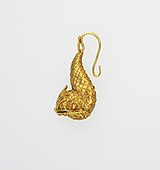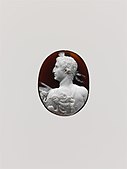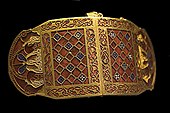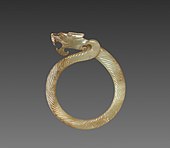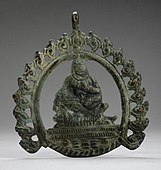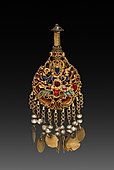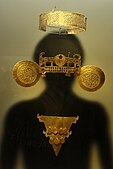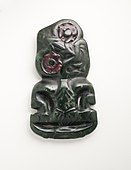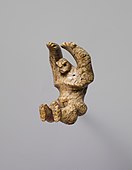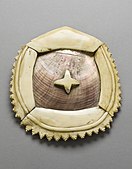Jewellery
Jewellery (or jewelry in American English) consists of decorative items worn for personal adornment, such as brooches, rings, necklaces, earrings, pendants, bracelets, and cufflinks. Jewellery may be attached to the body or the clothes. From a western perspective, the term is restricted to durable ornaments, excluding flowers for example. For many centuries metal such as gold often combined with gemstones, has been the normal material for jewellery, but other materials such as glass, shells and other plant materials may be used.
Jewellery is one of the oldest types of
Jewellery may be made from a wide range of materials.
The word jewellery itself is derived from the word jewel, which was
Form and function
Humans have used jewellery for a number of different reasons:
- functional, generally to fix clothing or hair in place.
- as a marker of social status and personal status, as with a wedding ring
- as a signifier of some form of affiliation, whether ethnic, religious or social
- to provide talismanic protection (in the form of amulets)[4]
- as an artistic display
- as a carrier or symbol of personal meaning – such as love, mourning, a personal milestone or even luck
- generally considered as a good investment
- superstition[5]
Most[
Many items of jewellery, such as brooches and buckles, originated as purely functional items, but evolved into decorative items as their functional requirement diminished.[8]
Jewellery can symbolise group membership (as in the case, of the Christian crucifix or the Jewish Star of David) or status (as in the case of chains of office, or the Western practice of married people wearing wedding rings).
Wearing of amulets and devotional medals to provide protection or to ward off evil is common in some cultures. These may take the form of symbols (such as the ankh), stones, plants, animals, body parts (such as the Khamsa), or glyphs (such as stylised versions of the Throne Verse in Islamic art).[9]
Materials and methods

In creating jewellery,
Other commonly used materials include glass, such as fused-glass or enamel; wood, often carved or turned; shells and other natural animal substances such as bone and ivory; natural clay; polymer clay; Hemp and other twines have been used as well to create jewellery that has more of a natural feel. However, any inclusion of lead or lead solder will give a British Assay office (the body which gives U.K. jewellery its stamp of approval, the Hallmark) the right to destroy the piece, however it is very rare for the assay office to do so.
Diamonds
Diamonds were first mined in India.[11] Pliny may have mentioned them, although there is some debate as to the exact nature of the stone he referred to as Adamas.[12] In 2005, Australia, Botswana, Russia and Canada ranked among the primary sources of gemstone diamond production.[13] There are negative consequences of the diamond trade in certain areas. Diamonds mined during the recent civil wars in Angola, Ivory Coast, Sierra Leone, and other nations have been labelled as blood diamonds when they are mined in a war zone and sold to finance an insurgency.[14]
The

Now popular in engagement rings, this usage dates back to the marriage of Maximilian I to Mary of Burgundy in 1477.[15]
A popular style is the diamond solitaire, which features a single large diamond mounted prominently.[16] Within solitaire, there are three categories in which a ring can be classified: prong, bezel and tension setting.[17]
Other gemstones
Many precious and semiprecious stones are used for jewellery. Among them are:
- Amber
- Amber, an ancient organic gemstone, is composed of tree resin that has hardened over time. The stone must be at least one million years old to be classified as amber, and some amber can be up to 120 million years old.
- Amethyst
- Amethyst has historically been the most prized gemstone in the quartz family. It is treasured for its purple hue, which can range in tone from light to dark.
- Emerald
- Emeralds are one of the three main precious gemstones (along with rubies and sapphires) and are known for their fine green to bluish green colour. They have been treasured throughout history, and some historians report that the Egyptians mined emerald as early as 3500 BC.
- Jade
- Jade is most commonly associated with the colour green but can come in a number of other colours as well. Jade is closely linked to Asian culture, history, and tradition, and is sometimes referred to as the stone of heaven.
- Jasper
- Jasper is a gemstone of the chalcedony family that comes in a variety of colours. Often, jasper will feature unique and interesting patterns within the coloured stone. Picture jasper is a type of jasper known for the colours (often beiges and browns) and swirls in the stone's pattern.
- Quartz
- Quartz refers to a family of crystalline gemstones of various colours and sizes. Among the well-known types of quartz are Citrine, are also part of the quartz family. Rutilated quartzis a popular type of quartz containing needle-like inclusions.
- Ruby
- Rubies are known for their intense red colour and are among the most highly valued precious gemstones. Rubies have been treasured for millennia. In Sanskrit, the word for ruby is ratnaraj, meaning king of precious stones.
- Sapphire
- The most popular form of sapphire is blue sapphire, which is known for its medium to deep blue colour and strong saturation. Fancy sapphires of various colours are also available. In the United States, blue sapphire tends to be the most popular and most affordable of the three major precious gemstones (emerald, ruby, and sapphire).
- Turquoise
- Turquoise is found in only a few places on earth, and the world's largest turquoise-producing region is the southwest United States. Turquoise is prized for its attractive colour, most often an intense medium blue or a greenish blue, and its ancient heritage. Turquoise is used in a great variety of jewellery styles. It is perhaps most closely associated with southwest and Native American jewellery, but it is also used in many sleek, modern styles. Some turquoise contains a matrix of dark brown markings, which provides an interesting contrast to the gemstone's bright blue colour.
Some gemstones (like pearls, coral, and amber) are classified as organic, meaning that they are produced by living organisms. Others are inorganic, meaning that they are generally composed of and arise from minerals.
Some gems, for example, amethyst, have become less valued as methods of extracting and importing them have progressed. Some man-made gems can serve in place of natural gems, such as cubic zirconia, which can be used in place of diamond.[18]
Metal finishes
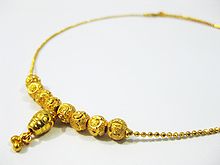
For
Some jewellery is plated to give it a shiny, reflective look or to achieve a desired colour. Sterling silver jewellery may be plated with a thin layer of 0.999 fine silver (a process known as flashing) or may be plated with rhodium or gold. Base metal costume jewellery may also be plated with silver, gold, or rhodium for a more attractive finish.
Impact on society
Jewellery has been used to denote status. In ancient Rome, only certain ranks could wear rings and[19] later, sumptuary laws dictated who could wear what type of jewellery. This was also based on rank of the citizens of that time.
Cultural dictates have also played a significant role. For example, the wearing of earrings by Western men was considered effeminate in the 19th century and early 20th century. More recently, the display of body jewellery, such as
Conversely, the jewellery industry in the early 20th century launched a campaign to popularise wedding rings for men, which caught on, as well as engagement rings for men, which did not, going so far as to create a false history and claim that the practice had medieval roots. By the mid-1940s, 85% of weddings in the U.S. featured a double-ring ceremony, up from 15% in the 1920s.[20]
Some religions have specific rules or traditions surrounding jewellery (or even prohibiting it) and many religions have edicts against excessive display. Islam, for instance, considers the wearing of gold by men as
History
The history of jewellery is long and goes back many years, with many different uses among different cultures. It has endured for thousands of years and has provided various insights into how ancient cultures worked.
Prehistory
The earliest known Jewellery was actually created not by humans (Homo sapiens) but by Neanderthal living in Europe. Specifically, perforated beads made from small sea shells have been found dating to 115,000 years ago in the Cueva de los Aviones, a cave along the southeast coast of Spain. Later in Kenya, at Enkapune Ya Muto, beads made from perforated ostrich egg shells have been dated to more than 40,000 years ago. In Russia, a stone bracelet and marble ring are attributed to a similar age.[23]
Later, the
Around seven-thousand years ago, the first sign of copper jewellery was seen.[8] In October 2012 the Museum of Ancient History in Lower Austria revealed that they had found a grave of a female jewellery worker – forcing archaeologists to take a fresh look at prehistoric gender roles after it appeared to be that of a female fine metal worker – a profession that was previously thought to have been carried out exclusively by men.[25]
-
String of beads; 3650–3100 BC;Naqada II or Naqada III cultures; Metropolitan Museum of Art(New York City)
-
String of beads; 3300–3100 BC;steatite; length: 20.5 centimetres (8.1 in); by Naqada IIIculture Metropolitan Museum of Art
-
Armlet with sun symbol; 16th–13th century BC (lateNürnberg)
-
Necklace; probably 2600–1300 BC; carnelian, bone and stone; from Saruq Al Hadid (the United Arab Emirates)
Africa
Egypt
The first signs of established jewellery making in
In conjunction with gold jewellery, Egyptians used coloured glass, along with semi-precious gems. The colour of the jewellery had significance. Green, for example, symbolised fertility. Lapis lazuli and silver had to be imported from beyond the country's borders.
Egyptian designs were most common in
-
Pectoral (chest jewellery) of Tutankhamun; 1336–1327 BC (Reign of Tutankhamun); gold, silver and meteoric glass; height: 14.9 cm (5.9 in); Egyptian Museum (Cairo)
-
Pendant; c. 1069 BC; gold and turquoise; overall: 5.1 by 2.3 centimetres (2.01 in × 0.91 in); Cleveland Museum of Art (Cleveland)
-
Signet ring; 664–525 BC; gold; diameter: 3 by 3.4 centimetres (1.2 in × 1.3 in); British Museum (London)
-
Pectoral and necklace of Princess Sithathoriunet; 1887–1813 BC; gold, carnelian, lapis lazuli, turquoise, garnet & feldspar; height of the pectoral: 4.5 centimetres (1.8 in); Metropolitan Museum of Art (New York City)

Maghreb countries in North Africa
Jewellery of the Berber cultures is a style of traditional jewellery worn by women and girls in the rural areas of the Maghreb region in North Africa inhabited by indigenous Berber people (in Berber language: Amazigh, Imazighen, pl). Following long social and cultural traditions, the silversmiths of different ethnic Berber groups of Morocco, Algeria and neighbouring countries created intricate jewellery to adorn their women and that formed part of their ethnic identity. Traditional Berber jewellery was usually made of silver and includes elaborate brooches made of triangular plates and pins (fibula), originally used as clasps for garments, but also necklaces, bracelets, earrings and similar items.
Another major type is the so-called
Europe and the Middle East
The first gold jewellery from Bulgaria
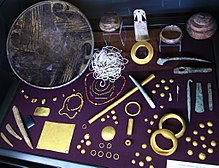
The oldest gold jewelry in the world is dating from 4,600 BC to 4,200 BC and was discovered in Europe, at the site of Varna Necropolis, near the Black Sea coast in Bulgaria.[28][29][30]
Several prehistoric Bulgarian finds are considered no less old – the golden treasures of Hotnitsa, Durankulak, artifacts from the Kurgan settlement of Yunatsite near Pazardzhik, the golden treasure Sakar, as well as beads and gold jewellery found in the Kurgan settlement of Provadia – Solnitsata (“salt pit”). However, Varna gold is most often called the oldest since this treasure is the largest and most diverse.[31]
Mesopotamia

By approximately 5,000 years ago, jewellery-making had become a significant craft in the cities of
Jewellery in Mesopotamia tended to be manufactured from thin metal leaf and was set with large numbers of brightly coloured stones (chiefly agate, lapis, carnelian, and jasper). Favoured shapes included leaves, spirals, cones, and bunches of grapes. Jewellers created works both for human use and for adorning statues and idols. They employed a wide variety of sophisticated metalworking techniques, such as cloisonné, engraving, fine granulation, and filigree.[33]
Extensive and meticulously maintained records pertaining to the trade and manufacture of jewellery have also been unearthed throughout Mesopotamian archaeological sites. One record in the Mari royal archives, for example, gives the composition of various items of jewellery:
- 1 necklace of flat speckled chalcedony beads including: 34 flat speckled chalcedony bead, [and] 35 gold fluted beads, in groups of five.
- 1 necklace of flat speckled chalcedony beads including: 39 flat speckled chalcedony beads, [with] 41 fluted beads in a group that make up the hanging device.
- 1 necklace with rounded lapis lazuli beads including: 28 rounded lapis lazuli beads, [and] 29 fluted beads for its clasp.[34]
-
Sumerian necklace beads; 2600–2500 BC; gold and lapis lazuli; length: 54 centimetres (21 in); Metropolitan Museum of Art
-
Necklace; 2600–2500 BC; gold and lapis lazuli; length: 22.5 centimetres (8.9 in); Royal Cemetery at Ur (Iraq); Metropolitan Museum of Art
-
Pair of earrings with cuneiform inscriptions, 2093–2046 BC; gold; Sulaymaniyah Museum (Sulaymaniyah, Iraq)
-
Sumerian necklaces and headgear discovered in the royal (and individual) graves of the Royal Cemetery at Ur, showing the way they may have been worn, in British Museum (London)
Greece
The Greeks started using gold and gems in jewellery in 1600 BC, although beads shaped as shells and animals were produced widely in earlier times. Around 1500 BC, the main techniques of working gold in Greece included casting, twisting bars, and making wire.
Jewellery in
They worked two styles of pieces: cast pieces and pieces hammered out of sheet metal. Fewer pieces of cast jewellery have been recovered. It was made by casting the metal onto two stone or clay moulds. The two halves were then joined, and wax, followed by molten metal, was placed in the centre. This technique had been practised since the late Bronze Age. The more common form of jewellery was the hammered sheet type. Sheets of metal would be hammered to thickness and then soldered together. The inside of the two sheets would be filled with wax or another liquid to preserve the metal work. Different techniques, such as using a stamp or engraving, were then used to create motifs on the jewellery. Jewels may then be added to hollows or glass poured into special cavities on the surface.
The Greeks took much of their designs from outer origins, such as Asia, when Alexander the Great conquered part of it. In earlier designs, other European influences can also be detected. When Roman rule came to Greece, no change in jewellery designs was detected. However, by 27 BC, Greek designs were heavily influenced by the Roman culture. That is not to say that indigenous design did not thrive. Numerous polychrome butterfly pendants on silver foxtail chains, dating from the 1st century, have been found near Olbia, with only one example ever found anywhere else.[38]
-
Mycenaean necklace; 1400–1050 BC; gilded terracotta; diameter of the rosettes: 2.7 centimetres (1.1 in), with variations of circa 0.1 centimetres (0.039 in), length of the pendant 3.7 centimetres (1.5 in); Metropolitan Museum of Art (New York City)
-
The Ganymede Jewellery; circa 300 BC; gold; various dimensions; provenance unknown (said to have been found near Thessaloniki, Greece); Metropolitan Museum of Art
-
Necklace; circa 200 BC; gold,cornelian, baroque pearl and banded agate; overall: 39.4 centimetres (15.5 in); Cleveland Museum of Art (Cleveland)
Etruscan
Gorgons, pomegranates, acorns, lotus flowers and palms were a clear indicator of Greek influence in Etruscan jewellery. The modelling of heads, which was a typical practice from the Greek severe period, was a technique that spread throughout the Etruscan territory. An even clearer evidence of new influences is the shape introduced in the Orientalizing era: The Bullae. A pear shaped vessel used to hold perfume. Its surface was usually decorated with repoussé and engraved symbolic figures.
Much of the jewellery found was not worn by Etruscans, but were made to accompany them in the after world. Most, if not all, techniques of Etruscan goldsmiths were not invented by them as they are dated to the third millennium BC.
-
TheVulci set of jewelry; early 5th century; gold, glass, rock crystal, agate and carnelian; various dimensions; Metropolitan Museum of Art(New York City)
-
Earring in the form of a dolphin; 5th century BC; gold; 2.1 by 1.4 by 4.9 centimetres (0.83 in × 0.55 in × 1.93 in); Metropolitan Museum of Art
-
Bulla with Daedalus and Icarus; 5th century BC; gold; 1.6 by 1 by 1 centimetre (0.63 in × 0.39 in × 0.39 in); Walters Art Museum (Baltimore)
-
Earring; gold and silver; 1.5 by 0.4 by 1.4 centimetres (0.59 in × 0.16 in × 0.55 in); Metropolitan Museum of Art
Rome
Although jewellery work was abundantly diverse in earlier times, especially among the barbarian tribes such as the
Like the Greeks, often the purpose of Roman jewellery was to ward off the "Evil Eye" given by other people. Although women wore a vast array of jewellery, men often only wore a finger
-
sardonyx; 3.7 by 2.9 by 0.8 centimetres (1.46 in × 1.14 in × 0.31 in); Metropolitan Museum of Art(New York City)
-
Bracelet; 1st–2nd century AD; gold-mounted crystal and sardonyx; length: 19.69 centimetres (7.75 in); Los Angeles County Museum of Art (Los Angeles)
-
Necklace with a medallion depicting a goddess; 30–300 AD; green glass (the green beads) and gold; length: 43.82 centimetres (17.25 in); Los Angeles County Museum of Art
Middle Ages
Post-Roman Europe continued to develop jewellery making skills. The
The Eastern successor of the Roman Empire, the Byzantine Empire, continued many of the methods of the Romans, though religious themes came to predominate. Unlike the Romans, the Franks, and the Celts, however, Byzantium used light-weight gold leaf rather than solid gold, and more emphasis was placed on stones and gems. As in the West, Byzantine jewellery was worn by wealthier females, with male jewellery apparently restricted to signet rings. Woman's jewellery had some peculiarities like kolts that decorated headband. Like other contemporary cultures, jewellery was commonly buried with its owner.[44]
-
The Eagle-shaped fibulae of Alovera; 5th century; gold, bronze and glass (imitation of garnet); height: 11.8 centimetres (4.6 in), width: 5.9 centimetres (2.3 in); fromNational Archaeological Museum (Madrid, Spain)
-
Shoulder-clasps from Sutton Hoo; early 7th century; gold, glass & garnet; length: 12.7 centimetres (5.0 in); British Museum (London)
-
Pair of Byzantine earrings; 7th century; gold, pearls, glass andemeralds; 10.2 by 4.5 centimetres (4.0 in × 1.8 in); Cleveland Museum of Art (Cleveland)
-
Front of a temple pendant with two birds flanking a tree of life; 11th–12th century; cloisonné enamel & gold; overall: 5.4 by 4.8 by 1.5 centimetres (2.13 in × 1.89 in × 0.59 in); made in Kyiv (Ukraine); Metropolitan Museum of Art (New York City)
Renaissance
The
When
shell cameos instead of stone cameos. New terms were coined to differentiate the arts: jewellers who worked in cheaper materials were called bijoutiers, while jewellers who worked with expensive materials were called joailliers, a practice which continues to this day.Romanticism

Starting in the late 18th century,
In the United States, this period saw the founding in 1837 of
This period also saw the first major collaboration between East and West. Collaboration in Pforzheim between German and Japanese artists led to Shakudō plaques set into Filigree frames being created by the Stoeffler firm in 1885).[47] Perhaps the grand finalé – and an appropriate transition to the following period – were the masterful creations of the Russian artist Peter Carl Fabergé, working for the Imperial Russian court, whose Fabergé eggs and jewellery pieces are still considered as the epitome of the goldsmith's art.
18th century/Romanticism/Renaissance
Many whimsical fashions were introduced in the extravagant eighteenth century. Cameos that were used in connection with jewellery were the attractive trinkets along with many of the small objects such as brooches, ear-rings and scarf-pins. Some of the necklets were made of several pieces joined with the gold chains were in and bracelets were also made sometimes to match the necklet and the brooch. At the end of the Century the jewellery with cut steel intermixed with large crystals was introduced by an Englishman, Matthew Boulton of Birmingham.[48]
Art Nouveau
In the 1890s, jewellers began to explore the potential of the growing
Art Nouveau jewellery encompassed many distinct features including a focus on the female form and an emphasis on colour, most commonly rendered through the use of enamelling techniques including basse-taille, champleve, cloisonné, and plique-à-jour. Motifs included orchids, irises, pansies, vines, swans, peacocks, snakes, dragonflies, mythological creatures, and the female silhouette.
The end of World War I once again changed public attitudes, and a more sober style developed.[49]
-
The Dragonfly brooch; byLisboa, Portugal)
-
Necklace; by René Lalique; 1897–1899; gold, enamel, opals and amethysts; overall diameter: 24.1 centimetres (9.5 in); Metropolitan Museum of Art (New York City)
-
The Snakes brooch; by René Lalique; gold and enamel; Calouste Gulbenkian Museum
-
Hair ornament, an Art Nouveau masterpiece; by René Lalique; c. 1902; gold, emeralds and diamonds; Musée d'Orsay (Paris)
Art Deco
Growing political tensions, the after-effects of the war, and a reaction against the perceived decadence of the turn of the 20th century led to simpler forms, combined with more effective manufacturing for mass production of high-quality jewellery. Covering the period of the 1920s and 1930s, the style has become popularly known as Art Deco. Walter Gropius and the German Bauhaus movement, with their philosophy of "no barriers between artists and craftsmen" led to some interesting and stylistically simplified forms. Modern materials were also introduced: plastics and aluminium were first used in jewellery, and of note are the chromed pendants of Russian-born Bauhaus master Naum Slutzky. Technical mastery became as valued as the material itself. In the West, this period saw the reinvention of granulation by the German Elizabeth Treskow, although development of the re-invention has continued into the 1990s. It is based on the basic shapes.
Asia
In Asia, the
China
The Chinese used
In China, the most uncommon piece of jewellery is the earring, which was worn neither by men nor women. were frequently depicted on jewellery designs.
The Chinese often placed their jewellery in their graves. Most Chinese graves found by
-
Fluted ring with a dragon head (huan); circa 475 BC; jade (nephrite); overall: 9.1 centimetres (3.6 in); Cleveland Museum of Art (Cleveland)
-
Ornament with flowers and grapes design; 1115–1234; jade; Shanghai Museum (China)
-
Xin 心 shaped jewelry; 1368–1644; gold, ruby, pearl and other gemstones; about the size of an adult human's palm;Dingling (Beijing, China)
-
Hat ornament; 18th–19th century; gold, gilded metal, kingfisher feathers, glass and semiprecious stones; various dimensions; Metropolitan Museum of Art (New York City)
Indian subcontinent

The
Jewellery in the
A female skeleton (presently on display at the National Museum, New Delhi, India) wears a carlinean bangle (bracelet) on her left hand. Kada is a special kind of bracelet and is widely popular in Indian culture. They symbolize animals such as peacock, elephant, etc.[56]
According to Hindu belief, gold and silver are considered as sacred metals. Gold is symbolic of the warm sun, while silver suggests the cool moon. Both are the quintessential metals of Indian jewellery. Pure gold does not oxidise or corrode with time, which is why Hindu tradition associates gold with immortality. Gold imagery occurs frequently in ancient Indian literature. In the Vedic Hindu belief of cosmological creation, the source of physical and spiritual human life originated in and evolved from a golden womb (hiranyagarbha) or egg (hiranyanda), a metaphor of the sun, whose light rises from the primordial waters.[57]
Jewellery had great status with India's royalty; it was so powerful that they established laws, limiting wearing of jewellery to royalty. Only royalty and a few others to whom they granted permission could wear gold ornaments on their feet. This would normally be considered breaking the appreciation of the sacred metals. Even though the majority of the Indian population wore jewellery, Maharajas and people related to royalty had a deeper connection with jewellery. The Maharaja's role was so important that the Hindu philosophers identified him as central to the smooth working of the world. He was considered as a divine being, a deity in human form, whose duty was to uphold and protect dharma, the moral order of the universe.[58] The largest ever single order to Cartier was made in 1925 by the Indian royalty, the Maharaja of Patiala, for the Patiala Necklace and other jewelry worth ₹1,000 million (equivalent to ₹210 billion, US$2.7 billion or €2.6 billion in 2023).[59]
Navaratna (nine gems) is a powerful jewel frequently worn by a Maharaja (Emperor). It is an amulet, which comprises diamond, pearl, ruby, sapphire, emerald, topaz, cat's eye, coral, and hyacinth (red zircon). Each of these stones is associated with a celestial deity, represented the totality of the Hindu universe when all nine gems are together. The diamond is the most powerful gem among the nine stones. There were various cuts for the gemstone. Indian Kings bought gemstones privately from the sellers. Maharaja and other royal family members value gem as Hindu God. They exchanged gems with people to whom they were very close, especially the royal family members and other intimate allies.
India was the first country to mine diamonds, with some mines dating back to 296 BC. India traded the diamonds, realising their valuable qualities. Historically, diamonds have been given to retain or regain a lover's or ruler's lost favour, as symbols of tribute, or as an expression of fidelity in exchange for concessions and protection. Mughal emperors and Kings used the diamonds as a means of assuring their immortality by having their names and worldly titles inscribed upon them. Moreover, it has played and continues to play a pivotal role in Indian social, political, economic, and religious event, as it often has done elsewhere. In Indian history, diamonds have been used to acquire military equipment, finance wars, foment revolutions, and tempt defections. They have contributed to the abdication or the decapitation of potentates. They have been used to murder a representative of the dominating power by lacing his food with crushed diamond. Indian diamonds have been used as security to finance large loans needed to buttress politically or economically tottering regimes. Victorious military heroes have been honoured by rewards of diamonds and also have been used as ransom payment for release from imprisonment or abduction.[60]
Today, many jewellery designs and traditions are used, and jewellery is commonplace in Indian ceremonies and
-
Pendant probably with Siddha; 8th–9th century; copper alloy; 8.89 by 7.93 by 0.31 centimetres (3.50 in × 3.12 in × 0.12 in); Los Angeles County Museum of Art (Los Angeles)
-
Earring with Vishnu riding Garuda; c. 1600; gold set with jewels and semi-precious stones; overall: 2.6 centimetres (1.0 in); from Nepal; Cleveland Museum of Art (Cleveland)
-
Earring with four-armed Vishnu riding Garuda with Nagas (serpent divinities); c. 1600; repousse gold with pearls; overall: 3.6 cm; from Nepal; Cleveland Museum of Art
-
Comb with Vishnu adored by serpents; 1750–1800; ivory with traces of paint; 6.99 by 7.94 centimetres (2.75 in × 3.13 in); from Nepal; Los Angeles County Museum of Art
North and South America

Jewellery making started in the Americas with the arrival of
With the Moche culture, goldwork flourished. The pieces are no longer simple metalwork, but are now masterful examples of jewellery making. Pieces are sophisticated in their design, and feature inlays of turquoise, mother of pearl, spondylus shell, and amethyst. The nose and ear ornaments, chest plates, small containers and whistles are considered masterpieces of ancient Peruvian culture.[62] A notable example of Andean metallurgy is the Northern Andean cultures' work with

Among the Late Post-Classic Aztecs, only nobility wore gold jewellery, as it showed their rank, power, and wealth. A large portion of "Aztec gold" jewellery was created by Mixtec artisans. The Mixtecs were particularly known for their goldwork and gold jewellery was part of the tribute paid by Mixtec polities to the Aztecs. In general, the more jewellery an Aztec noble wore, the higher his status or prestige. The Emperor and his High Priests, for example, would be nearly completely covered in jewellery when making public appearances. Although gold was the most common and a popular material used in Aztec jewellery, jade, turquoise, and certain feathers were considered more valuable.[64] In addition to adornment and status, the Aztecs also used jewellery in sacrifices to appease the gods.[26][46]
Another ancient American civilization with expertise in jewellery making were the Maya. During the Pre-Classic and Classic era of Maya civilization, the Maya were making jewellery from local materials such as jade, pearls, and sea shell while also incorporating imported materials such as obsidian and turquoise. In the Terminal Classic and Post-Classic, importation of gold, silver, bronze, and copper lead to the use of these materials in jewellery. Merchants and nobility were the only few that wore expensive jewellery in the Maya region, much the same as with the Aztecs.[54] Jade in particular had an important role across Mesoamerica.
In Northern America, Native Americans used shells, wood, turquoise, and soapstone The turquoise was used in necklaces and to be placed in earrings. The turquoise incorporated into Mesoamerican jewellery was primarily obtained through trade with Oasisamerica. Native Americans with access to oyster shells, often located in only one location in America, traded the shells with other tribes, showing the great importance of the body adornment trade in Northern America.[65]
Jewellery played a major role in the fate of the Americas when the Spanish colonizers were spurred to search for gold on the American mainland after coming into contact with Caribbean natives that had gold jewellery obtained through trade with the mainland. Continued contact with Native Americans wearing gold jewellery eventually lead to Spanish expeditions of the mythological El Dorado.
-
Pendant made from a spondylus shell, Western Mexico shaft tomb tradition, 200 BC to 200 AD, now at the Art Institute of Chicago, United States.
-
Muisca gold jewellery, including a headband, nose ornament and pectoral, on display at the Gold Museum in Bogota, Colombia.
-
Moche nose ornament made from silver and gold-silver alloy, inlaid with malachite, now at the Cleveland Museum of Art, United States.
-
Mixtec-Puebla style labret made from obsidian in the shape of an eagle, now at the Walters Art Museum in Baltimore, United States.
Native American
Native American jewellery is the personal adornment, often in the forms of necklaces, earrings, bracelets, rings, pins, brooches, labrets, and more, made by the
Within the Haida Nation of the Pacific Northwest, copper was used as a form of jewellery for creating bracelets.[67]
Metalsmiths, beaders, carvers, and lapidaries combine a variety of metals, hardwoods, precious and semi-precious gemstones, beadwork, quillwork, teeth, bones, hide, vegetal fibres, and other materials to create jewellery. Contemporary Native American jewellery ranges from hand-quarried and processed stones and shells to computer-fabricated steel and titanium jewellery.
Pacific
Jewellery making in the
Jewellery in the Pacific, with the exception of Australia, is worn to be a symbol of either fertility or power. Elaborate headdresses are worn by many Pacific cultures and some, such as the inhabitants of Papua New Guinea, wear certain headdresses once they have killed an enemy. Tribesman may wear boar bones through their noses.
Island jewellery is still very much primal because of the lack of communication with outside cultures. Some areas of Borneo and Papua New Guinea are yet to be explored by Western nations. However, the island nations that were flooded with Western missionaries have had drastic changes made to their jewellery designs. Missionaries saw any type of tribal jewellery as a sign of the wearer's devotion to paganism. Thus many tribal designs were lost forever in the mass conversion to Christianity.[68]
Australia is now the number one supplier of opals in the world. Opals had already been mined in Europe and South America for many years prior, but in the late 19th century, the Australian opal market became predominant. Australian opals are only mined in a few select places around the country, making it one of the most profitable stones in the Pacific.[69]
The New Zealand Māori traditionally had a strong culture of personal adornment,[70] most famously the hei-tiki. Hei-tikis are traditionally carved by hand from bone, nephrite, or bowenite.
Nowadays a wide range of such traditionally inspired items such as bone carved pendants based on traditional fishhooks hei matau and other greenstone jewellery are popular with young New Zealanders of all backgrounds – for whom they relate to a generalized sense of New Zealand identity. These trends have contributed towards a worldwide interest in traditional Māori culture and arts.
Other than jewellery created through Māori influence, modern jewellery in New Zealand is multicultural and varied.[68]
-
Musée du quai Branly – Jacques Chirac(Paris)
-
Hei-tiki; 18th century; nephrite and haliotis shell; 10.9 centimetres (4.3 in); from the New Zealand; Los Angeles County Museum of Art (Los Angeles)
-
Hawaiian pendant; 18th–19th century; whalebone; height: 6 centimetres (2.4 in), width, 3.8 centimetres (1.5 in); Metropolitan Museum of Art (New York City)
-
Breast Ornament (civa vonovono); c. 1850; whale ivory, pearl shell and fiber; height: 12.7 centimetres (5.0 in), diameter: 17.78 centimetres (7.00 in); from Fiji; Los Angeles County Museum of Art
Modern


Most modern commercial jewellery continues traditional forms and styles, but designers such as
The

The late 20th century saw the blending of European design with oriental techniques such as
Also,
More expansive use of metal to adorn the wearer, where the piece is larger and more elaborate than what would normally be considered jewellery, has come to be referred to by designers and fashion writers as metal couture.[73][74]
Masonic
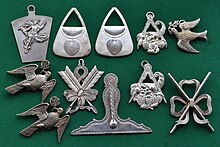
Body modification
Jewellery used in body modification can be simple and plain or dramatic and extreme. The use of simple silver studs, rings, and earrings predominates. Common jewellery pieces such as earrings are a form of body modification, as they are accommodated by creating a small hole in the ear.
In the late twentieth century, the influence of modern primitivism led to many of these practices being incorporated into western subcultures. Many of these practices rely on a combination of body modification and decorative objects, thus keeping the distinction between these two types of decoration blurred.
In many cultures, jewellery is used as a temporary body modifier; in some cases, with hooks or other objects being placed into the recipient's skin. Although this procedure is often carried out by tribal or semi-tribal groups, often acting under a trance during religious ceremonies, this practice has seeped into western culture. Many extreme-jewellery shops now cater to people wanting large hooks or spikes set into their skin. Most often, these hooks are used in conjunction with pulleys to hoist the recipient into the air. This practice is said to give an erotic feeling to the person and some couples have even performed their marriage ceremony whilst being suspended by hooks.[75]
Jewellery market
According to a 2007 KPMG study,[77] the largest jewellery market is the United States with a market share of 31%, Japan, India, China, and the Middle East each with 8–9%, and Italy with 5%. The authors of the study predicted a dramatic change in market shares by 2015, where the market share of the United States will have dropped to around 25%, and China and India will increase theirs to over 13%. The Trend of buying jewellery online is also increasing day by day, as a result the best quality jewellery can be provided at a cheaper price to any part of India via many online shops. The Middle East will remain more or less constant at 9%, whereas Europe's and Japan's market share will be halved and become less than 4% for Japan, and less than 3% for the biggest individual European countries, Italy and the UK.
See also
- Bronze and brass ornamental work
- Estate jewelry
- Heirloom
- Gemology
- Jewellery cleaning
- Jewellery of the Berber cultures
- Jewellery Quarter
- Jewelry Television
- List of jewellery types
- List of topics characterized as pseudoscience (healing jewelry)
- Live insect jewelry
- Suffrage jewellery
- Wire sculpture
References
- ^ Study reveals 'oldest jewellery' Archived 2018-06-12 at the Wayback Machine, BBC News, June 22, 2006.
- ^ jewel. (n.d.). Archived 2016-03-07 at the Wayback Machine Dictionary.com Unabridged (v 1.1). Retrieved on August 7, 2007, from the Dictionary.com website.
- ^ see American and British spelling differences
- ^ Kunz, George Frederick (1917). Magic of Jewels and Charms. John Lippincott Co. URL: Magic Of jewels: Chapter VII Amulets Archived 2013-12-13 at the Wayback Machine George Frederick Kunz, a gemmologist for Tiffany's, built the collections of banker J.P. Morgan and of the American Natural History Museum in New York City. This chapter deals entirely with using jewels and gemstones in jewellery for talismanic purposes in Western cultures.
- ^
Manutchehr-Danai, Mohsen, ed. (2009). "magical jewelry". Dictionary of Gems and Gemology. Berlin: Springer. ISBN 978-3-540-72795-8.
magical jewelry [...] articles of jewelry worn for their magical belief, medicinal powers, or superstitions reasons.
- ^ "BBC – History – Ancient History in depth: Viking Money". Archived from the original on 2014-02-10. Retrieved 2017-11-10.
- ^ Web Team, Victoria and Albert Museum, Online Museum (2011-01-13). "Trade Beads". www.vam.ac.uk. Archived from the original on 2022-01-08. Retrieved 2017-11-10.
{{cite web}}: CS1 maint: multiple names: authors list (link) - ^ a b c Holland, J. 1999. The Kingfisher History Encyclopedia. Kingfisher books.
- ^
ISBN 1862045720.
- ISBN 1880140292.
- ^ "Home – GIA.edu" (PDF). gia.edu. Archived from the original (PDF) on 2007-09-26.
- ^ Pliny. Natural History, XXXVI, 15
- ^ "Natural Diamond: World Production, By Country And Type". indexmundi.com. Archived from the original on 2018-06-25. Retrieved 2007-08-07.
- ^ "How the African Diamond Trade Works". HowStuffWorks. 2008-04-21. Retrieved 2024-01-22.
- ^ "Diamonds Are a Girl's Worst Friend: The trouble with engagement rings". Archived 2011-09-24 at the Wayback Machine. by Meghan O'Rourke at Slate.com, June 11, 2007.
- ^ "What is a Solitaire Setting". GIA.edu. Gemological Institute of America. 6 June 2012. Archived from the original on 21 December 2019. Retrieved 21 December 2019.
- ^ "What does solitaire ring look like?". TIDAN. tidanapp.com. Archived from the original on 5 December 2021. Retrieved 6 May 2020.
- ISBN 0801967732.
- ^ Pliny the Elder. The Natural History. ed. John Bostock, Henry Thomas Riley, Book XXXIII The Natural History of Metals Online at the Perseus Project Archived 2008-04-11 at the Wayback Machine Chapter 4. Accessed July 2006
- ^ Howard, Vicky. "A real Man's Ring: Gender and the Invention of Tradition." Journal of Social History, Summer 2003, pp 837–856.
- ^ Yusuf al-Qaradawi. The Lawful and Prohibited in Islam (online) Archived 2011-10-13 at the Wayback Machine
- ^ Greenbaum, Toni. "Silver Speaks: Traditional Jewelry From the Middle East". Metalsmith, Winter 2004, Vol. 24, Issue 1, p. 56. Greenbaum provides the explanation for the lack of historical examples
- ^ "Stone Bracelet May Have Been Made by Denisovans". 2015. Archived from the original on 2018-09-25. Retrieved 2015-05-10.
A stone bracelet unearthed in Denisova Cave in the Altai Mountains of Siberia in 2008 is being called the oldest-known jewelry of its kind. Anatoly Derevyanko, director of the Russian Academy of Sciences' Institute of Archaeology and Ethnography, and the research team believe that the cave's Denisovan layers were uncontaminated by human activity from a later period. The soil around the two fragments of the jewelry piece was dated with oxygen isotopic analysis to 40,000 years ago. "In the same layer, where we found a Denisovan bone, were found interesting things; until then it was believed these were the hallmark of the emergence of Homo sapiens. First of all, there were symbolic items, such as jewelry, including the stone bracelet as well as a ring, carved out of marble," Derevyanko told The Siberian Times
- doi:10.11141/ia.40.8. Archived(PDF) from the original on 2018-07-22.
- ^ The Austrian Independent News and Pictures. "Cavewoman jeweller rewrites gender history". austrianindependent.com. Archived from the original on 2012-10-07. Retrieved 2012-10-05.
- ^ ISBN 0864380070
- from the original on 2023-07-18. Retrieved 2023-12-08.
- ^ [1] Archived 2022-11-01 at the Wayback Machine Gems and Gemstones: Timeless Natural Beauty of the Mineral World, By Lance Grande
- ^ (https://www.smithsonianmag.com/travel/varna-bulgaria-gold-graves-social-hierarchy-prehistoric-archaelogy-smithsonian-journeys-travel-quarterly-180958733/ Archived 2023-07-18 at the Wayback Machine)
- ^ (https://www.smithsonianmag.com/smart-news/oldest-gold-object-unearthed-bulgaria-180960093/ Archived 2019-09-28 at the Wayback Machine)
- ^ "Archaeologists have discovered the oldest treasure in the world – Afrinik". 15 May 2021. Archived from the original on 26 December 2021. Retrieved 8 December 2023.
- ^ Nemet-Nejat, Daily Life, 155–157.
- ^ Nemet-Nejat, Daily Life, 295–297.
- ^ Nemet-Nejat, Daily Life, 297.
- ISBN 978-0500519585.
- ISBN 978-0714100548.
- ISBN 978-0936227191.
- .
- ISBN 978-0500519585.
- JSTOR 25509045
- ^ Duby Georges and Philippe Ariès, eds. A History of Private Life Vol 1 – From Pagan Rome to Byzantium. Harvard, 1987. p 506
- ^ Duby, throughout.
- ^ Sherrard, P. (1972). Great Ages of Man: Byzantium. Time-Life International.
- ISBN 0810937751p. 77.
- ^ a b Farndon, J. (2001). 1,000 Facts on Modern History. Miles Kelly Publishing.
- ^ Ilse-Neuman, Ursula. Book review Schmuck/Jewellery 1840–1940: Highlights from the Schmuckmuseum Pforzheim. Metalsmith. Fall2006, Vol. 26 Issue 3, pp. 12–13
- ISBN 978-1289626945.
- ISBN 1577150740as well as Ilse-Neuman 2006.
- ^ Pal, Sanchari. "Maharajas, Myths and Mysteries: The Fascinating History of India's Jewels and Jewellery". Archived from the original on 2023-11-19. Retrieved 2023-11-19.
- ^ ISBN 0810938863. p. 15.
- ^ Lu, Peter J., "Early Precision Compound Machine from Ancient China." Science, 6/11/2004, Vol. 304, Issue 5677
- ^ Yuan, Li (27 March 2019). "No Earrings, Tattoos or Cleavage: Inside China's War on Fun". the new york times. Archived from the original on 2022-05-21. Retrieved 2022-05-21.
- ^ a b c Reader's Digest Association. 1983. Vanished Civilisations. Reader's Digest.
- ^ "Bangles". Tamilnadu.com. 4 March 2013. Archived from the original on 18 October 2013. Retrieved 14 March 2013.
- ^ "When showstopper Juhi walked down the ramp". The Times of India. Archived from the original on 14 June 2013. Retrieved 16 June 2013.
- ISBN 978-0810938861.
- ISBN 978-0865652187.
- ^ From Bahadur Shah Zafar to the Nizam of Hyderabad, a jewellery brand for the royals Archived 2023-09-30 at the Wayback Machine, The Print, 5 Nov 2022.
- ^ Prior, Katherine (2000). Traditional Jewelry of India. New York: Vendome. p. 312.
- ^ Kaur, Prabhjot. "Women and Jewelry – The Traditional and Religious Dimensions of Ornamentation".
- ISBN 978-9972934124.
- ^ "Ancient Platinum Technology in South America". technology.matthey.com. Archived from the original on 22 April 2023. Retrieved 22 April 2023.
- ISBN 978-0500050682.
- ^ Josephy Jr, A.M. (1994). 500 Nations: The Illustrated History of North American Indians. Alfred A. Knopf. Inc.
- ^ Dubin, 17
- ^ "Haida Jewelry". Archived from the original on 16 March 2020. Retrieved 22 January 2020.
- ^ ISBN 1869535359.
- ^ Dorling Kindersley Ltd. 1989. Facts and Fallacies: Stories of the Strange and Unusual. Reader's Digest. 11–13.
- ^ "Maori customary adornment". Te Papa. 2010-06-02. Archived from the original on 2010-06-02.
Maori made and wore items of jewellery..."
- ^ McCrieght, Tim. "What's New?" Metalsmith Spring 2006, Vol. 26 Issue 1, pp. 42–45
- ^ "Nineteenth-Century American Jewelry". metmuseum.org. Archived from the original on 2006-12-14. Retrieved 2006-09-25.
- ^ Mohemad, Dena. "Manuel Albarran Metal Couture" Archived 2016-04-11 at the Wayback Machine. Pushit Journal – News
- ^ Ilbarra, Sabina (May 5, 2014) "Q & A with Manuel Albarran" Archived 2016-04-13 at the Wayback Machine. Living Out Loud
- ^ a b Packard, M. (2002). Ripley's Believe It or Not Special Edition. Scholastic Inc. p. 22.
- JSTOR 483428.
- ^ KPMG India (2007). "Global Jewelry Consumption". Gems and Gemology. XLIII (Summer 2007): 180.
Further reading
- Borel, F. 1994. The Splendor of Ethnic Jewelry: from the Colette and Jean-Pierre Ghysels Collection. New York: H.N. Abrams (ISBN 0810929937).
- Evans, J. 1989. A History of Jewellery 1100–1870 (ISBN 0486261220).
- LaGamma, Alisa (1991). Metropolitan jewelry. New York: The Metropolitan Museum of Art. ISBN 978-0870996160.
- Nemet-Nejat, Karen Rhea 1998. Daily Life in Ancient Mesopotamia. Westport, CT: Greenwood Press (ISBN 0313294976).
- Tait, H. 1986. Seven Thousand Years of Jewellery. London: British Museum Publications (ISBN 0714120340).
External links
- Jewellery at Curlie


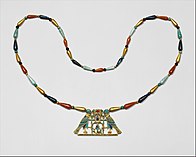




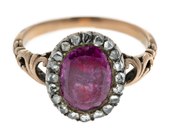








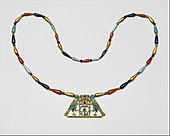



![The Bee Pendant, an iconic Minoan jewel; 1700–1600 BC; gold; width: 4.6 centimetres (1.8 in); from Chrysolakkos (gold pit) complex at Malia; Archaeological Museum of Heraklion (Heraklion, Greece)[39][40]](http://upload.wikimedia.org/wikipedia/commons/thumb/a/a9/Bee_pendant%2C_gold_ornament%2C_Chrysolakos_necropolis_near_Malia%2C_1800-1700_BC%2C_AMH%2C_144879.jpg/170px-Bee_pendant%2C_gold_ornament%2C_Chrysolakos_necropolis_near_Malia%2C_1800-1700_BC%2C_AMH%2C_144879.jpg)




